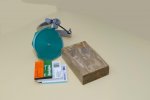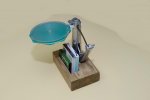For the last 20 years, I have been using one manner of hand primer or another. Lee, RCBS, and most recently, 21'st Century. All of the models I've used have a tray incorporated into their design. For low volume sessions, they have always worked fine. I can usually do about 200-300 before I feel my thumbs starting to fatigue. In the last 5-7 years however, I've been digesting about 10,000-20,000 or more of various cartridges per year. Often I will load 500-1000 in a single session. The hand priming tools have always been pretty fast, but they have had some problems as well.
The primer trays always leave me wanting. They are always plastic, and far to easy to upset causing primers to fly around the room. On some models such as the RCBS they are prone to popping out completely, while on others like the 21st Century, the lit wants to pop off. Changing primer size and shell holders on the RCBS is a pain. It's easy on the 21st Century, but the brass shell holders on the 21st century are easily ruined if you have a few stubborn (tight) primer pockets. Still, no matter the unit, after 200-300 cases... my thumbs are begging for mercy. Various other little annoyances exist, yet nothing was ever a show stopper.
Priming has always been one of my major safety concerns. I ALWAYS wear safety glasses when priming, and I always keep my fingers away, and point the case away from me when pressing a primer home. Still, there's a tray of explosives that reacts to impacts surrounded by plastic right in front of me, and it has always been nerve wracking. A single primer has a pretty good pop. A tray of primers would have to cause some damage. Until today, that was just a theory. Then I found this picture:

He had a primer go in wrong, and it set off a domino effect causing every primer in the tray to pop instantaneously. The tool becomes shrapnel, as if the primers themselves weren't bad enough. This poor dude got his face shredded, and his eye socket broken. I found this while researching other priming options after a 400rnd 6.5CM priming session yesterday. I'm always looking for ways to improve, in just about every area of my life. It occurs to me, that I have seated several hundred thousand primers in my life, and the law of greater numbers suggests I'll be having an accident at some point regardless of how careful I am. When that happens, do I want one primer to pop, or potentially 100 I have in the tray?
So, I'll be trying out a bench-mounted priming tool. My two candidates are the RCBS Auto Priming tool or the RCBS APS primer. The auto uses pickup tubes, while the APS uses plastic strips. From the looks of it, both seem to greatly reduce the chances of a domino effect, with the Auto Primer being decidedly safer in that regard. Though I've not used either of them.
I'm looking for some advice on which to get. Personal first-hand experiences only please. If you've used both, excellent! Give me a comparison. If you've only used one or the other, tell me all about it! If you've used neither, please remain silent, and forever hold your peace. If you have a line on a different bench-mounted unit suitable for high volume priming, I'm all ears.
The primer trays always leave me wanting. They are always plastic, and far to easy to upset causing primers to fly around the room. On some models such as the RCBS they are prone to popping out completely, while on others like the 21st Century, the lit wants to pop off. Changing primer size and shell holders on the RCBS is a pain. It's easy on the 21st Century, but the brass shell holders on the 21st century are easily ruined if you have a few stubborn (tight) primer pockets. Still, no matter the unit, after 200-300 cases... my thumbs are begging for mercy. Various other little annoyances exist, yet nothing was ever a show stopper.
Priming has always been one of my major safety concerns. I ALWAYS wear safety glasses when priming, and I always keep my fingers away, and point the case away from me when pressing a primer home. Still, there's a tray of explosives that reacts to impacts surrounded by plastic right in front of me, and it has always been nerve wracking. A single primer has a pretty good pop. A tray of primers would have to cause some damage. Until today, that was just a theory. Then I found this picture:

He had a primer go in wrong, and it set off a domino effect causing every primer in the tray to pop instantaneously. The tool becomes shrapnel, as if the primers themselves weren't bad enough. This poor dude got his face shredded, and his eye socket broken. I found this while researching other priming options after a 400rnd 6.5CM priming session yesterday. I'm always looking for ways to improve, in just about every area of my life. It occurs to me, that I have seated several hundred thousand primers in my life, and the law of greater numbers suggests I'll be having an accident at some point regardless of how careful I am. When that happens, do I want one primer to pop, or potentially 100 I have in the tray?
So, I'll be trying out a bench-mounted priming tool. My two candidates are the RCBS Auto Priming tool or the RCBS APS primer. The auto uses pickup tubes, while the APS uses plastic strips. From the looks of it, both seem to greatly reduce the chances of a domino effect, with the Auto Primer being decidedly safer in that regard. Though I've not used either of them.
I'm looking for some advice on which to get. Personal first-hand experiences only please. If you've used both, excellent! Give me a comparison. If you've only used one or the other, tell me all about it! If you've used neither, please remain silent, and forever hold your peace. If you have a line on a different bench-mounted unit suitable for high volume priming, I'm all ears.






